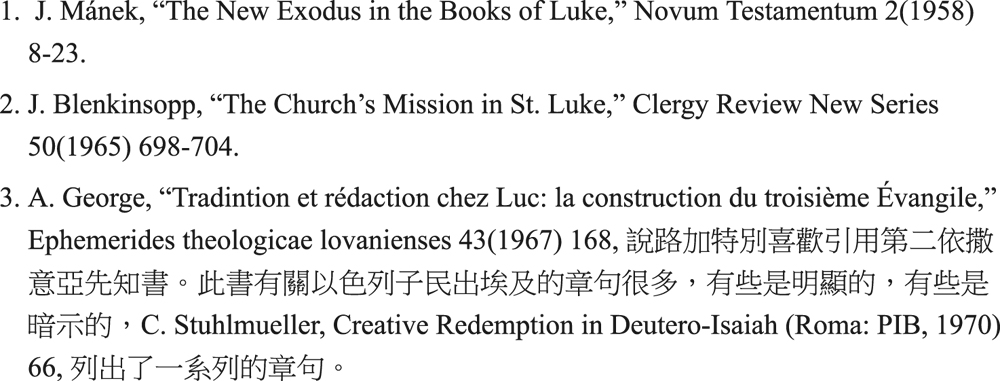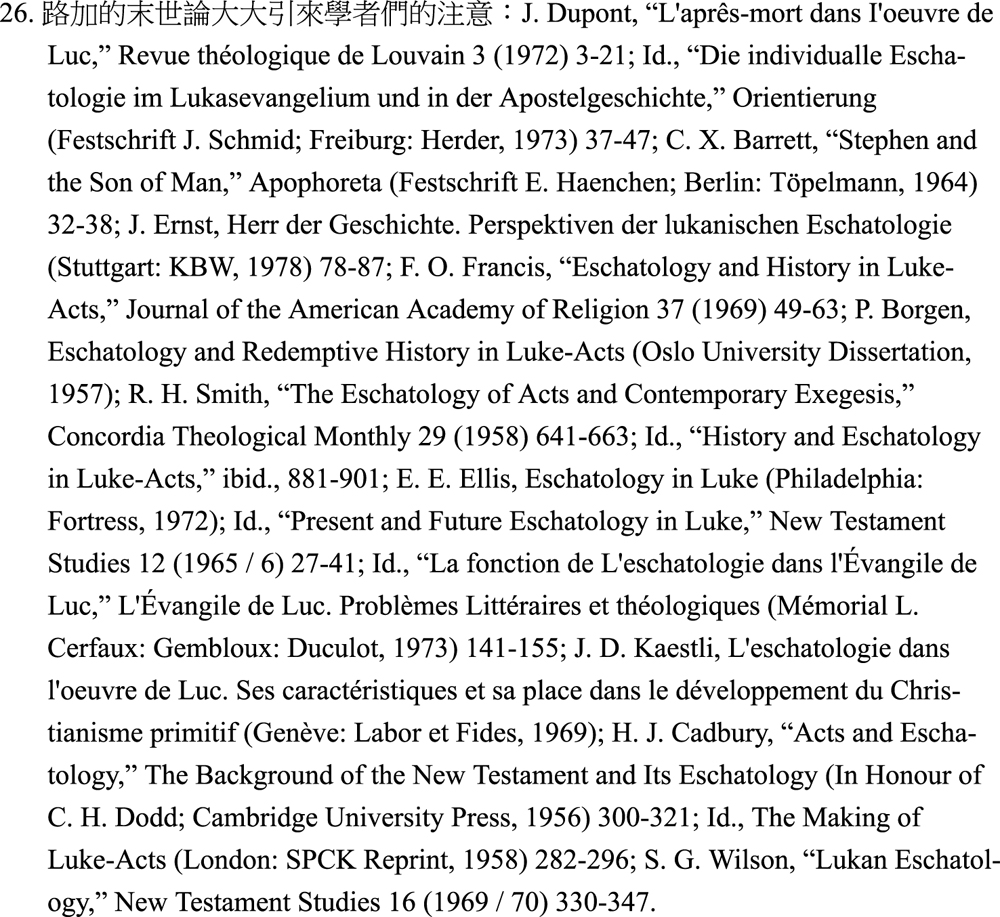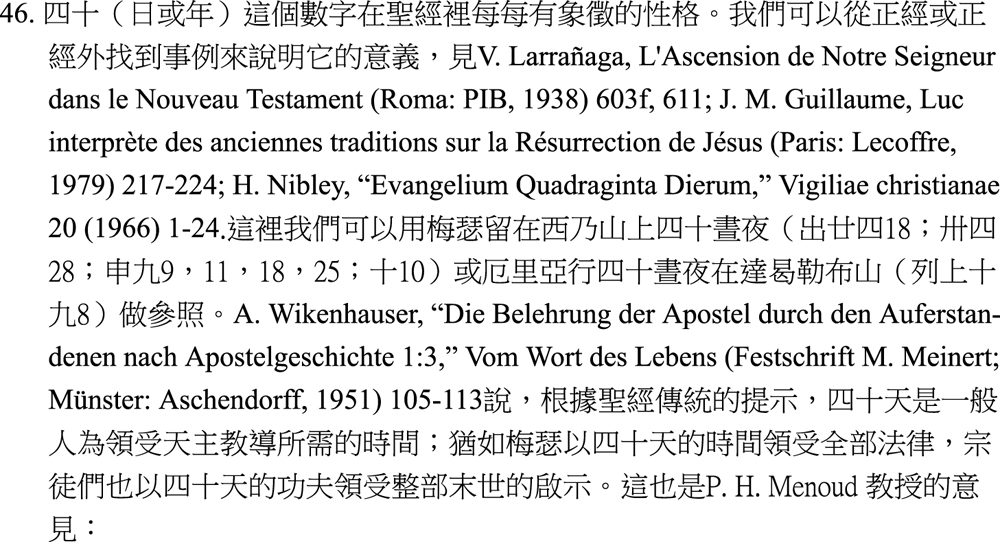神學論集

附註:

- 路加用eisodos (eiserchesthai), exodos (exerchesthai):路九31;宗一21後;十三24。參閱 W. C. Robinson, Der Weg des Herrn. Studien zur Geschichte und Eschatologie im Lukas-Evangelium (Hamburg-Bergstedt: Reich, 1964) 39-43; I. H. Marshall, Luke: Historian and Theologian (Exeter: Paternoster, 1970) 148-153.
- 它的希臘文同義語是dromos:宗十三25;廿24;弟後四7。
- 我們如把路九57∼62與瑪八19∼22作個比較,很易發覺兩者的不同:(一)路加在57a為整段的記載安上了一個框架:「他們正走的時候,在路上……。」(二)在59節,他特別強調耶穌的邀請:「你跟隨我吧。」(三)最後,他加多了兩節半的描寫:60b說明耶穌召收門徒的目的是為宣揚天主的國;61∼62節是用列上十九19∼21的故事為背景來襯托出耶穌對他自己人的要求多過厄里亞對厄里叟的要求。

- J. 'Starky, “Obfirmavit faciem suam,” Recherches de science religieuse 39 (1951) 197-202.
- F. V. Filson, “The Journey Motif in Luke-Acts,” Apostolic History and the Gospel (Essays presented to F. F. Bruce on His 60th Birthday; ed. W. W. Gasque and R. P. Martin; Grand Rapids: Eerdmanns, 1970) 70.
- 參閱七十士譯本智三2;七6。
- 參閱七十士譯本詠一O四38;一一三1。
 (見註1.); J. G. Davies, “The Prefigurement of the Ascension in the Third Gospel,” Journal of Theological Studies 56 (1955) 229-233.
(見註1.); J. G. Davies, “The Prefigurement of the Ascension in the Third Gospel,” Journal of Theological Studies 56 (1955) 229-233.- 這個字的動詞的被動語態見於新舊約的有下列數處:谷十六19;弟前三16;宗一2,11,22;列下二11;加上二58;德四十八9;四十九16。在猶太人的傳統裡,這個詞是對哈諾客(Enoch)、梅瑟和厄里亞三人用的,因為他們很神妙的失蹤了,又因為大家相信他們沒有經過死亡便到另一個世界去了。可能為了這個理由,在耶穌變容的敘述中,路加加插上梅瑟和厄里亞,讓他們談論耶穌去世的事 (exodos). 見G. Delling in Theological Dictionary of the New Testament, IV, 7-9; C. F. Evans, “The Central Section of St. Luke's Gospel,” Studies in the Gospel (Essays in Memory of R. H. Lightfoot; ed. D. E. Nineham; Oxford: Blackwell, 1955) 38ff.; P. A. van Stempvoort, “The Interpretation of the Ascension in Luke and Acts,” New Testament Studies 5 (1958 / 9) 32-34; J. G. Davies, He Ascended into Heaven. A Study in the History of a Doctrine (London: Lutterworth, 1958) chapter 1; B. M. Metzger, “The Ascension of Jesus Christ,” Historical and Literary Studies (Leiden: Brill, 1968) 80-81, n. 1; R. Koch, “Taking up,” Sacramentum Verbi. An Encyclopedia of Biblical Theology (ed. J. B. Bauer; tr. J. Blenkinsopp and Others; New York: Herder, 1970), III, 897-899.

- 同樣的詞也用在宗十二17,參閱W. M. Smaltz, “Did Peter die in Jerusalem?” Journal of Biblical Literature 71 (1952) 211-216, 但作者說伯鐸死於耶路撒冷的監獄中則未免太冒險了。
- 見W. Bauer, A Greek-English Lexicon of the New Testament and Other Early Christian Literature (tr. and rev. W. F. Arndt and F. W. Gingrich; The University of Chicago Press, 1957).
- 同樣的詞用於路廿二22,33及宗一25,留意它們彼此間的關係。
- W. Grundmann, Das Evangelium nach Lukas (Berlin: Evangelischer Verlag, 6 Auflage, 1971) 18, 454ff.
- 宗三15;五31;參閱希二10:
 (救生的嚮導);W. Manson, The Epistle to the Hebrews (London: Hodder, 1951)用下面的比喻來說明:一個善於游泳的救生員帶著繩索渡過急流,讓他後面的人握著繩索可以安然渡過。
(救生的嚮導);W. Manson, The Epistle to the Hebrews (London: Hodder, 1951)用下面的比喻來說明:一個善於游泳的救生員帶著繩索渡過急流,讓他後面的人握著繩索可以安然渡過。 - 參閱E. Haenchen. The Acts of the Apostles (tr. from German by R. M. Wilson and Others; Oxford: Blackwell, 1971) 給宗三15下的註。
- 路加慣用strapheis(轉過身來)這個動作來描寫耶穌:路七9,44;九55;十23;十四25;廿二61;廿三28。
- 宗九2;十九9,23;廿二4;廿四14,22。
- 路廿四7,46,26;參閱 E. M. Prevallet, Luke 24:26. A Passover Christology (Marquette University Dissertation, 1967).
- H. J. Cadbury, “Lexical Notes on Luke-Acts,” Journal of Biblical Literature 44 (1925) 220:「路加以階段完成或時機已到的觀點來討論歷史及啟示的問題」。

- C. K. Barrett, Luke, the Historian in Recent Study (London: Epworth, 1961) 56f.
- P. A. van Stempvoort, (見註13.)39ff.
- H. Flender, St. Luke Theologian of Redemptive History (translated from German by R. H. and I. Fuller; London: SPCK, 1967); J. H. E. Hull, The Holy Spirit in the Acts of the Apostles (London: Lutterworth, 1967) 157f.

- J. Navone, Themes of St. Luke (Roma: PUG, 1970) 71-87; A. von Harnack, Beitr?ge zur Einleitung in das Neue Testament, III. Die Apostelgeschichte (Leipzig: Hinrichs, 1908) 207-210.
- G. Girardet, I1 Vangelo della liberazione. Lettura politica di Luca (Roma: Claudiana, 1976); A. Paoli, La radice dell'uomo. Meditazione sul Vangelo di Luca (Brescia: Morcelliana, 1972); F. W. Danker, Jesus and the New Age according to St. Luke. A Commentary on the Third Gospel (St. Louis: Clayton, 1972) xvi-xvii and passim; T. Reese, “The Political Theology of Luke-Acts,” Biblical Theology 22 (1972) 62-65; R. L. Cassidy, Jesus, Politics and Society. A Study of Luke's Gospel (Maryknoll: Orbis, 1978); R. E. Brown, “The Beatitudes according to Luke,” New Testament Essays (Milwaukee: Bruce, 1963) 271:「路加福音是馬克斯福音針鋒相對的勁敵」。
- F.
 , Der leidende Christus. Die angefochtene Gemeinde und das Christuskerygma der lukanischen Schriften (Stuttgart: Kohlhammer, 1969) 113ff.; E. Hammel, “La donna e la promozione della giustizia nel ‘Magnificat’,” Rassegna di Teologia 18 (1977) 417-433.
, Der leidende Christus. Die angefochtene Gemeinde und das Christuskerygma der lukanischen Schriften (Stuttgart: Kohlhammer, 1969) 113ff.; E. Hammel, “La donna e la promozione della giustizia nel ‘Magnificat’,” Rassegna di Teologia 18 (1977) 417-433. - 耶穌教訓人愛仇時,他揭示要人模仿的標準,根據路加的記載是天主的仁慈(六36,
 ),根據瑪竇的記載是天主的成全(五48,teleios)。T. W. Manson, The Sayings of Jesus (London: SCM Reprint, 1971) 55, 認為路加的說法較為可取,因為在舊約裡,仁慈是天主的特徵,很少用於人。在新約裡,
),根據瑪竇的記載是天主的成全(五48,teleios)。T. W. Manson, The Sayings of Jesus (London: SCM Reprint, 1971) 55, 認為路加的說法較為可取,因為在舊約裡,仁慈是天主的特徵,很少用於人。在新約裡, ,
,  , polysplagchnos, splagchnizomai及由它們引申而來的字都是同義語,多數對天主而用:見格後一3;雅五11;路一50,54,58,72,78;七13;十33;十五20(最後的兩個例,雖然直接指的不是天主,但暗示的無疑就是祂)。根據猶太經師的教導(Sotah 14a),送衣贈物給受寒的窮人、慰問遭遇喪事的家屬、探望病者、安葬亡者,都是法天的行為(imitatio Dei),梅瑟法律由此而始,至此而終。
, polysplagchnos, splagchnizomai及由它們引申而來的字都是同義語,多數對天主而用:見格後一3;雅五11;路一50,54,58,72,78;七13;十33;十五20(最後的兩個例,雖然直接指的不是天主,但暗示的無疑就是祂)。根據猶太經師的教導(Sotah 14a),送衣贈物給受寒的窮人、慰問遭遇喪事的家屬、探望病者、安葬亡者,都是法天的行為(imitatio Dei),梅瑟法律由此而始,至此而終。 - H. J. Degenhardt, Lukas: Evangelist der Armen. Besitz und Besitzverzicht in den lukanischen Schriften. Eine traditions-und redaktionsgeschichtliche Untersuchung (Stuttgart: KBW, 1965); R. Koch, “Die Wertung des Besitzes im Lukasevangelium,” Biblica 38 (1957) 157-169; A.
 , “Armut und Ehelosigkeit. Besitz und Ehe der
, “Armut und Ehelosigkeit. Besitz und Ehe der  nach dem Lukasevangelium,” Geist und Leben 40 (1967) 43-59; J. Navone (見註31.), 103-117; Th. Hoyt, The Poor in Luke-Acts (Duke University Dissertation, 1974/5).
nach dem Lukasevangelium,” Geist und Leben 40 (1967) 43-59; J. Navone (見註31.), 103-117; Th. Hoyt, The Poor in Luke-Acts (Duke University Dissertation, 1974/5). - 路加在福音裡兩次提到耶穌講論謙遜的話(十四11;十八14)。瑪利亞讚美主的詩歌(The Magnificat)除了對天主的仁慈歌功頌德外,也對謙遜這一美德大加讚揚。謙遜是路加福音中段的主要話題之一,見C. F. Evans, “The Central Section of St. Luke's Gospel,” Studies in the Gospel (Essays in Memory of R. H. Lightfoot; Oxford: Blackwell, 1955) 52.
- 見註6.。
- F. V. Filson, “The Journey Motif in Luke-Acts,” Apostolic History and the Gospel (Essays presented to F. F. Bruce on His 60th Birthday; Grand Rapids: Eerdmans, 1970) 68f.; E.
 , Jesus Means Freedom (tr. from German by F. Clarke; London: SCM, 1969) 101-129, 這一章的題目富有啟發性:The Long Road. The Epistle to the Hebrews and Luke-Acts.有關路加的著作與希伯來書的共同點可參閱C. P. M. Jones, “The Epistle to the Hebrews and the Lucan Writings,” Studies in the Gospel(見註13.),113-143; R. D. Kaylor, The Ascension Motif in Luke-Acts, the Epitle to the Hebrews and the Fourth Gospel (Duke University Dissertation, 1964).
, Jesus Means Freedom (tr. from German by F. Clarke; London: SCM, 1969) 101-129, 這一章的題目富有啟發性:The Long Road. The Epistle to the Hebrews and Luke-Acts.有關路加的著作與希伯來書的共同點可參閱C. P. M. Jones, “The Epistle to the Hebrews and the Lucan Writings,” Studies in the Gospel(見註13.),113-143; R. D. Kaylor, The Ascension Motif in Luke-Acts, the Epitle to the Hebrews and the Fourth Gospel (Duke University Dissertation, 1964). - Ernst(見註26.),87f, 112.
- Barrett(見註27.),59ff.
- K. H. Schelkle, An Introduction to the New Testament (tr. from German by G. Kirstein; Cork: Mercier, 1969) 150f; W. G.
 , Introduction to the New Testament (tr. from German by A. J. Mattill Jr.; London: SCM, 1966) 243,認為這封信是保祿寫的;反對此見者有Bultmann,
, Introduction to the New Testament (tr. from German by A. J. Mattill Jr.; London: SCM, 1966) 243,認為這封信是保祿寫的;反對此見者有Bultmann,  , Bornkamm, Schweizer, Schoeps等人。
, Bornkamm, Schweizer, Schoeps等人。 - 路廿二26後,見R. C. Tannehill, “Study in the Theology of Luke-Acts,” Anglican Theological Review 43 (1961) 200.
- C. H. Dodd, The Parables of the Kingdom (Revised ed.; Glasgow: Collins Fontana, 1965) ch. 6.
- 路加的「旅途」神學跟近代用存在主義哲學闡釋死亡的神學有頗多異曲同工之處,而這又跟教會傳統的克己苦身的觀念及保祿宗徒對洗禮及修行的訓導不謀而合,可參閱K. Rahner, On the Theology of Death (tr. from German by G. H. Henkey; New York: Herder, 1961); L. Boros, The Moment of Truth. Mysterium Mortis (tr. from German by G. Bainbridge; London: Burns & Oates, 1965); R. Troisfontaines, I do not die (tr. from French by F. E. Albert; New York:
 , 1963).
, 1963). - 我們不排除這裡有厄里亞做預像的可能性。宗徒大事錄所描繪的耶穌升天的情景與列王紀下二8後所描寫的頗為相似;而
 這一詞既可用於梅瑟,又可用於厄里亞,參閱P. Dabeck, “Siehe, es erschienen Moses und Elias,” Biblica 23 (1942) 182; J. H. Davies, “The Purpose of the Central Section of St. Luke's Gospel,” Texte und Untersuchungen 87 (Berlin: Akademie, 1964) 165ff; M. Miyoshi, Der Anfang des Reiseberichts. Lk 9:51-10:24 (Roma: PIB, 1974) 9. 不過我認為這裡以梅瑟做預像的可能性比較強,理由有二:(一)在最接近的上下文中,梅瑟生平的故事較厄里亞的有更多可比擬的地方;(二)稍加注意,我們可以發覺,路加在福音裡喜歡用厄里亞做預像,在宗徒大事錄裡卻喜歡用梅瑟做預像。
這一詞既可用於梅瑟,又可用於厄里亞,參閱P. Dabeck, “Siehe, es erschienen Moses und Elias,” Biblica 23 (1942) 182; J. H. Davies, “The Purpose of the Central Section of St. Luke's Gospel,” Texte und Untersuchungen 87 (Berlin: Akademie, 1964) 165ff; M. Miyoshi, Der Anfang des Reiseberichts. Lk 9:51-10:24 (Roma: PIB, 1974) 9. 不過我認為這裡以梅瑟做預像的可能性比較強,理由有二:(一)在最接近的上下文中,梅瑟生平的故事較厄里亞的有更多可比擬的地方;(二)稍加注意,我們可以發覺,路加在福音裡喜歡用厄里亞做預像,在宗徒大事錄裡卻喜歡用梅瑟做預像。
 “Remarques sur les textes de l'Ascension dans Luc-Actes.” Neutestamentliche Studien
“Remarques sur les textes de l'Ascension dans Luc-Actes.” Neutestamentliche Studien ![]() R. Bultmann (BZNW 21; Berlin:
R. Bultmann (BZNW 21; Berlin: , 1954) 148-156. 筆者本人不否認上述的意義,但認為四十這個數字也可能指以色列子民四十年在曠野的生活(申二7;八4;厄下九21),正如 R. E. Brown 說,基督教會的開始與以色列民族的開始有很多相似的地方: The Virginal Conception and Bodily Resurrection of Jesus (New York: Chapman, 1973) 104.由此可見預像是極富彈性而又可以多方面被引用的。
- 另一可以比照的事例是聖神在耶穌誕生(路一35)、耶穌開始傳教(三21後;四14後)及教會開始向外推廣時所扮演的角色。
- 路廿四6,大部份的抄本,連P75在內,都有這較長的一句。
- P. A. van Stempvoort(見註13.),37.
- D. Bosch, Die Heidenmission in der Zukunftsschau Jesu. Eine Untersuchung zur Eschatologie der synoptischen Evangelien (
 : Zwingli, 1959) 17.
: Zwingli, 1959) 17. - H. Conzelmann, The Theology of St. Luke (tr. from German by G. Buswell; London: Faber, 1960) 137ff.
- F. Hahn, Mission in the New Testment (tr. from German by F. Clarke; London: SCM, 1965) 47ff.
- 領導以民前進的火柱及雲柱象徵天主的鑒臨,見出十三21∼22;十四19∼20,24;卅三9∼10;四十34∼38;申一33;戶十四14;智十八3。
- 這些觀念及名稱,待日後有機會時再為讀者稍作介紹。